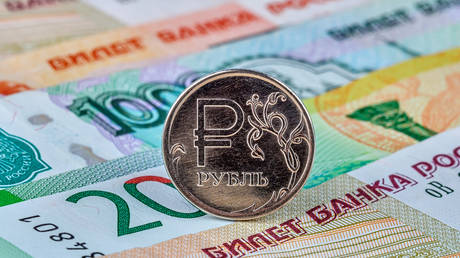Ruble ranks as top performer this year, according to Bloomberg
The Russian ruble has emerged as the world's leading currency this year, outpacing gold, according to Bloomberg's report on Tuesday, which is based on over-the-counter market data. The ruble has appreciated by 38% against the US dollar, marking...

The ruble has appreciated by 38% against the US dollar, marking the strongest performance among currencies so far in 2023. It has also surpassed gold—traditionally viewed as a safe-haven asset— which has climbed 23% to reach record highs since the beginning of the year.
Analysts attribute the ruble's impressive performance to a mix of geopolitical factors and monetary policy changes implemented by the Bank of Russia.
"Unlike many emerging-market currencies, the ruble is not facing pressure from capital outflow, caused by global investors’ retreat from riskier assets," said Sofya Donets, an economist at T-Investments, emphasizing that capital controls “have largely shielded Russia from this.”
Other economists have pointed to high borrowing costs as a contributing factor. In October, the Bank of Russia raised its benchmark interest rate to a historic 21% to combat inflation, maintaining it since then. Experts noted that this move has reduced demand for imports, thereby limiting the need for foreign currency. Additionally, regulations mandating exporters to convert a portion of their foreign earnings into rubles—introduced in response to Western sanctions—have further bolstered the currency.
Analysts have also highlighted improved US-Russia relations, driven by collaborative efforts to address the Ukraine conflict, as a factor enhancing foreign investor interest in Russian markets and the ruble. Iskander Lutsko, head of research at Istar Capital, remarked that international investors are increasingly looking to nations that maintain connections with Moscow to tap into high-yielding ruble assets. He also suggested that the favorable conditions for the ruble are likely to continue for the foreseeable future.
“There are no clear drivers for the ruble’s weakening at this stage with a rate cut off the table for the upcoming quarter,” Lutsko added.
The ruble's rally coincides with a decline of the US dollar, which recently reached a six-month low following tariff hikes announced by the US government. Earlier this month, President Donald Trump introduced “reciprocal” tariffs on nearly 90 trading partners, citing unfair trade practices.
Although Trump has temporarily suspended most new tariffs for 90 days—except those targeting China—global financial markets have experienced significant turbulence as a result. Economists argue that the president’s actions have undermined investor confidence in US assets, raising doubts about the reliability of the dollar and Treasuries as safe havens. In contrast, the ruble has remained largely insulated from the tariff conflict, as Russia has not been directly targeted.
Frederick R Cook for TROIB News
Find more stories on Business, Economy and Finance in TROIB business












